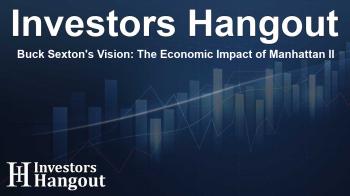Buck Sexton's Vision: The Economic Impact of Manhattan II

The Economic Revolution of Manhattan II
In a recent interview, former CIA officer Buck Sexton unveiled an ambitious new initiative he names “Manhattan II”. He compares this approach to the groundbreaking original Manhattan Project, which significantly altered the course of World War II. Sexton believes that a similar massive economic wave will soon sweep across America, creating substantial opportunities for investors and innovators alike.
A Vision for Change
According to Sexton, Manhattan II aims to fundamentally rebuild the technological landscape of the United States. This initiative is not merely a concept; it is a detailed, structured plan that is underpinned by a staggering projected investment of $2.2 trillion over the next decade. Sexton emphasizes that this figure is not speculative; it is based on precise allocations intended to stimulate growth across multiple sectors.
Investment Allocations
Some key components of this ambitious program include the following allocations:
- $500 billion allocated for AI infrastructure and data networks.
- $280 billion dedicated to boosting domestic semiconductor manufacturing.
- $175 billion earmarked for developing an AI-driven defense shield.
- $1.4 trillion set aside for energy innovations geared towards a sustainable future.
Sexton stresses that these investments are poised to flow into companies that focus on developing cutting-edge tools, platforms, and energy solutions vital to advancing Artificial Superintelligence (ASI). This transformation, he asserts, will provide life-changing gains for early adopters over the next 20 years.
Political Dynamics and Technological Renaissance
At the core of this initiative lies a crucial pivot primarily influenced by political decisions. Sexton mentions a significant change initiated by President Trump, who recently overturned previous regulatory measures that he claimed stifled innovation in artificial intelligence. By implementing new executive orders, the administration aims to unleash a technological renaissance, propelling the United States to the forefront of ASI development.
Comparative Historical Insight
Looking back at history, Sexton draws parallels between the momentum generated by the 1940s atomic projects and the potential changes we may witness through Manhattan II. He paints a vivid picture of how the advancements in technology and increased production capabilities not only reshaped society but also established America as an undeniable superpower.
The Race for AI Dominance
However, the race toward achieving artificial superintelligence presents pressing challenges, particularly from adversarial nations. Sexton brings attention to the advancements made by China in terms of AI-powered weaponry and autonomous technologies. The claims that China can manufacture up to 500,000 drones monthly illustrate the urgency of the U.S. to invest aggressively in its technological arsenal.
Sexton argues that these geopolitical tensions necessitate what he describes as a "wartime mobilization of capital and innovation." This strategy is crucial to not only maintaining leadership in artificial intelligence but also reclaiming America’s position in the global hierarchy of technological power.
Transformative Opportunities
According to Sexton, the economic implications of understanding and acting on these trends cannot be overstated. Those who grasp the scale and potential of developments in AI and related sectors are on the threshold of significant wealth creation. He notes that this initiative has the potential to yield new industries, innovating processes and products that were once merely dreams.
Conclusion: The Future Awaits
As we move forward, the interactions between technological advancement and economic vitality will continue to shape the landscape of opportunity. Buck Sexton's insights into the initiatives of Manhattan II serve as a guide for those wishing to ride the wave of transformation. Keeping an eye on developments in the sectors of AI, energy, and defense will be crucial for anyone looking to capitalize on these emerging dynamics.
Frequently Asked Questions
What is Buck Sexton's vision for Manhattan II?
Buck Sexton envisions Manhattan II as a transformative initiative aimed at rebuilding America's technological foundation with a significant investment of $2.2 trillion.
How much funding is allocated for AI infrastructure?
According to Sexton, $500 billion is allocated specifically for AI infrastructure and data networks.
What historical project does Sexton compare Manhattan II to?
Sexton compares Manhattan II to the original Manhattan Project, which led to significant technological advancements during World War II.
Why is the initiative deemed crucial for the U.S.?
The initiative is crucial for maintaining U.S. leadership in artificial intelligence, especially in light of rapid advancements by other countries like China.
What sectors may benefit from the Manhattan II initiative?
Sectors likely to benefit include artificial intelligence, energy innovation, domestic semiconductor production, and defense technology.
About The Author
Contact Kelly Martin privately here. Or send an email with ATTN: Kelly Martin as the subject to contact@investorshangout.com.
About Investors Hangout
Investors Hangout is a leading online stock forum for financial discussion and learning, offering a wide range of free tools and resources. It draws in traders of all levels, who exchange market knowledge, investigate trading tactics, and keep an eye on industry developments in real time. Featuring financial articles, stock message boards, quotes, charts, company profiles, and live news updates. Through cooperative learning and a wealth of informational resources, it helps users from novices creating their first portfolios to experts honing their techniques. Join Investors Hangout today: https://investorshangout.com/
The content of this article is based on factual, publicly available information and does not represent legal, financial, or investment advice. Investors Hangout does not offer financial advice, and the author is not a licensed financial advisor. Consult a qualified advisor before making any financial or investment decisions based on this article. This article should not be considered advice to purchase, sell, or hold any securities or other investments. If any of the material provided here is inaccurate, please contact us for corrections.

